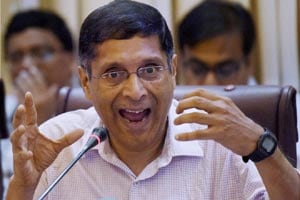Even if the coming monsoon turns out to be deficient, adequate food stocks with the government would keep inflation under control, the chief economic adviser in the finance ministry, Arvind Subramanian, said on Tuesday.
He added that economic growth in the short run would rely on consumption and public spending as other drivers of output like exports and private investment were looking down.
Stating that there was scope for monetary easing (“the fiscal policy is supportive”), he said retail inflation would remain range-bound at 5-5.5% in the current fiscal. Inflation, he said, was going to be lower than the Reserve Bank of India’s target (of less than 6% in January 2016). Drawing attention to China cutting its interest rates aggressively to make its currency more competitive, Subramanian said, “We need to respond accordingly.”
Addressing the media with an “interim update” of the economy as the Narendra Modi government completed a year in office, he said consumption and public investment had to pitch in given the weakness on the export front and “balance sheet stresses” in corporates and banks. A decline in the “(project) stalling rate” and “start of a pick-up”in real bank credit growth in Q4FY15 indicated things turning better, he said.
Capital expenditure by the Centre and states was slated to be substantial enough to live up to the promise, the CEA said. Even though the combined fiscal deficit of the Centre and states, he noted, was estimated to decline to 6.5% of GDP in the current fiscal from 6.9% last year, public capital expenditure was to increase from 4.6% to 5.1% of GDP (based on the central Budget and 17 state budgets).
Subramanian highlighted the 9.8% growth (net of additional revenue measures announced in the Budget) in indirect tax collections in April to presume a buoyancy of 0.9-0.8 and deduced that real GDP growth would be 7.7-9% (with GDP deflator of 3%). Some negatives were, however, noted too: Rural wage growth that had started declining from early 2014 seemed looking back towards the end of the year but slipped again recently; non-oil exports and non-oil/non-gold imports were “yet to recover” and services exports were “still weak”.
“Overall inflation is down, inflation prospects are looking good… The external situation is under reasonable control,” he said. The country’s wholesale price inflation hit its lowest in at least nine years at -2.65% in April and consumer price inflation dropped to a four-month low of 4.87% in the same month, but food inflation persisted at elevated levels in both the WPI and CPI (5.73% and 5.11%, respectively, for April). Food inflation has been higher than the headline WPI and CPI inflation consistently since December, although the impact of recent unseasonal rains on food prices has been much less than feared.
Some analysts feel the recent forecast of a 7% drop in seasonal monsoon showers from the normal level and its potential impact on inflation may still prompt the central bank to hold rates on June 2 when it meets to review its monetary policy, although most others expect the repo rate to be cut by 25 to 50 basis points. On April 7, the RBI had kept the repo rate unchanged at 7.5% and advised banks to work on monetary transmission and bankers subsequently responded to that call a bit.
The agriculture ministry has forecast a 5% drop in grain production during the current crop year ending June, mainly due to erratic weather. However, official reserves were brimming with food stocks, with grains held by state-run agencies having swelled to 51.17 million tonnes as of May 1, more than double the amount required under the norms governing buffer and strategic reserves.
Subramanian said the provision of 1% additional non-VATable tax on interstate supply of goods in the goods and services tax (GST) regime warranted a review as this could potentially make imports cheaper than domestic goods in some cases. “This (1% tax on inter-state trade sans set-off facility) has the potential to undermine Make in India… We need to re-examine it,” he said.
Subramanian said the 1% tax being origin-based was not in conformity with the GST, which is destination-based.
Also, there was the irony of it creating a situation where international trade would be favoured over intra-national trade. To illustrate, he said, a capital good transported overland from Gujarat to Tamil Nadu would cross four states, incurring 1% tax at each border, whereas the southern state could import the good from, say, Thailand, with a lower tax outgo.
For Updates Check Economy News; follow us on Facebook and Twitter
